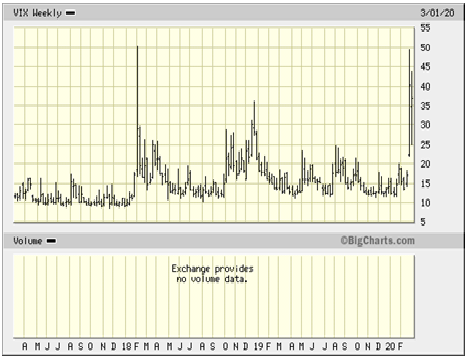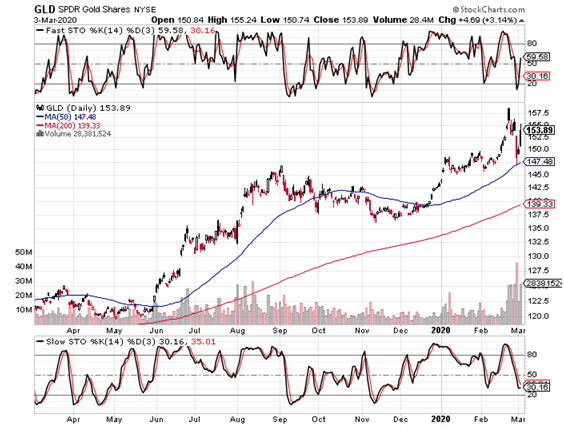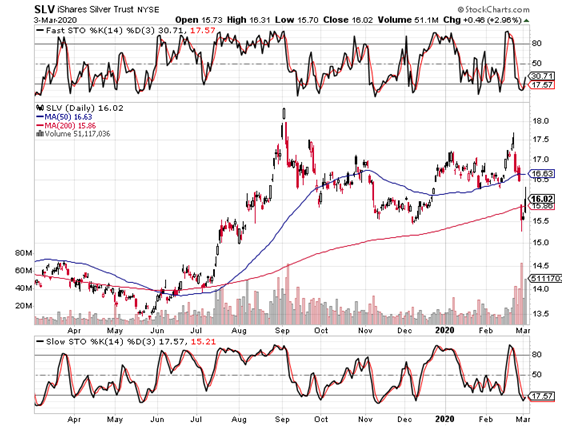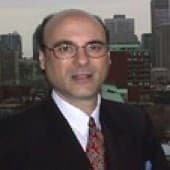Dow Analysis And Strategy:
From the February 26, 2020, pre-open report:
“I believe that it is wise to exit Dow put strategies on any new low. This includes the opening 15 minutes of market trading, if the Dow does not gap higher based on an intra-day short-covering rally that would actually begin at the open."
"In combination, these 2 charts tell us that PEAK put time premiums have been seen, even though new market lows should occur by ~March 1.”
The 1-year Dow chart and the 3-year VIX charts follow below, respectively. Placing the above in the context of these charts, we may conclude the following:
The market did indeed gap 500 points higher at the open, so the put-combination income and protection hedge program was only liquidated at the close at the 27,000 level. That level was a good one at which to exit positions, inasmuch as the market has since confirmed that 27,000 was the conclusion of this move’s wave-3 down.
Having forecast 27,000 as the end of wave-3, it had struck me as wise to conclude that peak option premiums were being seen, consistent with the historical behaviour between premiums and corresponding market phases (waves). However, I erred in liquidating with 3 days to go in the period (month).
As investors were getting clobbered, it seemed prudent to enjoy extraordinary double-digit results in the face of an arguably lofty VIX level at 30. However, the move to the February 2018 peak at 50 created windfall results that could have been enjoyed by following a couple of critical trading criteria.
The momentum indicators were not yet oversold, and there was little risk of giving back significant gains over the 3-day stretch that remained in the month. Markets tend to make extremes for month-end so, given the not-as-yet-oversold condition of the momentum indicators, coupled with the period’s end being only 3 days away should have been enough to remain true and do nothing. Amazingly, though far from unbelievably, the VIX did indeed peak by the beginning of March, despite attaining that 50-level.
We don’t often get 5,000 point moves, and the unusually large move to conclude the sequence (wave-5) had a significant compounding effect.
Ordinarily, wave-5 is not as pronounced relative to wave-3 (the heart of the move), but basic rules would have allowed one to capture “the overflowing juice.” This is not illogical second-guessing. I am merely being transparent.
In any event, the perfect sub-30,000 peak was forecast and identified in the reports, gains for the recommended program would have been sizeable if well-structured, and we now see momentum indicators which have turned up from the oversold levels that were seen by last week’s end.
To refresh, an appropriate put-combination strategy that is geared for these markets should provide positive results following a positive quarter, while aiming to profit in the 65-95% range after a bear market-style quarterly decline of 8 - 10%.

Last week’s report reminded that the put program aims to remain invested regardless whether or not the market is viewed as peaked or bottomed, the exception being when the VIX levels are too high post-liquidation (discussed below).
Last week’s article explained that the principal consideration in determining the timing for reinvestment after liquidation is the level of the VIX, so as to ensure not overpaying for the newly established combination. For this reason, the report added that the opportunity should present itself early this week (the article wrote “March 1,” which was a Sunday).
As the chart below reflects, the VIX fell to 25 when the Dow crawled over 27,000. The engineering of my own program calls for re-entry on a break of 27.5, so this suggests a newly opened combination. Since we are anywhere but at a peak, the aim of the engineering is to collect income that pays for the protection.

CONCLUSION
A reestablished put combination strategy (long and short contracts of different maturities and strike prices) should remain in-force, regardless any possible new lows, as put premiums are sold for income (which benefits from the anticipated countertrend move higher).
The Dow’s correction can overshoot to 28,100, at which point a more aggressive stance would likely be assumed, as was the case at the recent all-time-high. Ideally, the combination would have collected premiums that would have partly or wholly paid for the longer-dated portfolio put insurance.
Strategies are in step for the next wave within the 10,000 point top-to-bottom decline that was forecast in the December 2, 2019 and January 6, 2020 reports.
Silver (SLV) Analysis And Strategy:
The February 26, 2020 pre-open report wrote:
“Based on past experience, I believe that the majority of silver’s price correction is already over, with the coming four trading sessions mostly serving to batter call premiums (VXSLV). Once the weak hands have fallen out of the tree, silver should be ready to advance again.”
The 1-year gold (GLD (NYSE:GLD)) and Silver (NYSE:SLV) charts follow below.
Silver did indeed bottom with last week’s spike lower, largely caused, I believe, by retailers needing to meet margin calls by selling whatever wasn’t losing money (this would be consistent with last week’s brief co-directionality of stocks and silver). In any event, the stunning outperformance by gold versus silver is noteworthy and has caused me to include additional study later in this section.
First, today’s ~3% gains in each of the metals suggest that the risk is to the upside. Silver’s momentum indicators did become oversold and have turned higher, though not yet with any bullish divergence. However, that would require a new low and waiting for new lows in PMs would be foolhardy.
Gold’s momentum indicators never got oversold and, when gold’s bull is in force, it usually does not create that opportunity. This also plays into why silver’s price action invariably becomes a chase scene, so to speak, as it finally catches up to gold….and with plenty of attendant high drama.
As the SLV chart shows, the 6-month cycle low started to bottom a month early, in some of the recent semi-annual periods since 2016’s resumption of the PM bull market. Front-running has replaced window dressing that had involved commodity fund selling pressure.
The time cycle again worked, inasmuch as silver moved over $2 higher before falling back to the $15.50 area. Taking a short term bearish view, one would conclude that the break of the December low, however minor, coupled with the proximity of the next cycle low, would suggest waiting 3 months before jumping back in to establish short term speculations.
These are strange days, however, so please also note this section’s 3rd and 4th charts.


Consistent with the outperformance illustrated above by the gold and silver charts, please note the 100-year gold:silver ratio chart immediately below.

In 1940-41, the ratio approach 100. Based on the above, it did so again 50 years later in February 1991. Now, ~29 years later, the ratio has hit this sub-100 “Super-Summit” again. When taking a look at something similar in the Dow:silver ratio (not shown), the silver picture is potentially explosive.
I wrote that last week’s spike lower may have not only concluded a correction (I’m very confident of this), but it may have gotten rid of the retailer (“weak hands”) once and forever.
The 8-month VXSLV chart appears immediately below.
This picture of the SLV’s options’ time premiums explains why options have not been hurt relative to the price decline. The nearly 100% move higher from its 4th quarter low reflects this fact, but it also suggests that there is room for quite a premium hit if volatility were to cool down.
Still, the greatest risk is in selling silver, which is why I advised purchasing the 1 and 2-year calls (see previous reports), in the event that something nutty were to occur - something that could preclude one from enjoying the elegant 1st-half exit for which I had hoped, initiated by cycle-trading-based call writing against the longer-dated long positions.

CONCLUSION
Whether or not a sharp resistance level-shattering rally commences after May or starts sooner, I would expect the dramatic $10 eruption in 2020 to begin, as forecasted in the December 2, 2019 and January 6, 2020 reports.
